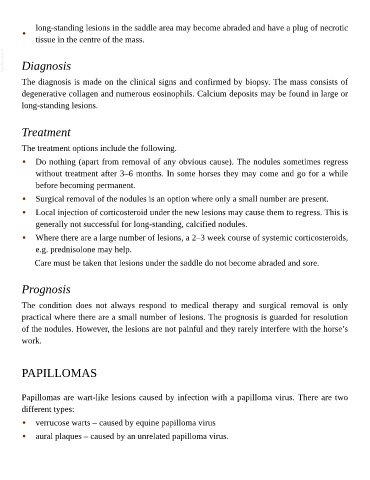Page 878 - The Veterinary Care of the Horse
P. 878
long-standing lesions in the saddle area may become abraded and have a plug of necrotic
•
tissue in the centre of the mass.
VetBooks.ir Diagnosis
The diagnosis is made on the clinical signs and confirmed by biopsy. The mass consists of
degenerative collagen and numerous eosinophils. Calcium deposits may be found in large or
long-standing lesions.
Treatment
The treatment options include the following.
• Do nothing (apart from removal of any obvious cause). The nodules sometimes regress
without treatment after 3–6 months. In some horses they may come and go for a while
before becoming permanent.
• Surgical removal of the nodules is an option where only a small number are present.
• Local injection of corticosteroid under the new lesions may cause them to regress. This is
generally not successful for long-standing, calcified nodules.
• Where there are a large number of lesions, a 2–3 week course of systemic corticosteroids,
e.g. prednisolone may help.
Care must be taken that lesions under the saddle do not become abraded and sore.
Prognosis
The condition does not always respond to medical therapy and surgical removal is only
practical where there are a small number of lesions. The prognosis is guarded for resolution
of the nodules. However, the lesions are not painful and they rarely interfere with the horse’s
work.
PAPILLOMAS
Papillomas are wart-like lesions caused by infection with a papilloma virus. There are two
different types:
• verrucose warts – caused by equine papilloma virus
• aural plaques – caused by an unrelated papilloma virus.

